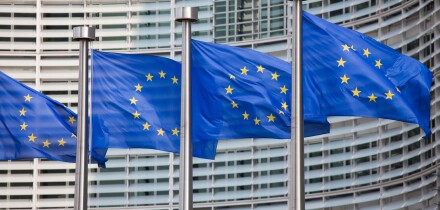
“Chaos in there today,” sighed a veteran New York Stock Exchange dealer after the closing bell of the cataclysmic trading session of Monday October 19, 1987. “Absolute chaos. I’ve never seen anything like it in almost 40 years on the floor. I hope to God I never see another day like this.”
“A meltdown” lamented NYSE chairman John Phelan. That day — Black Monday — the Dow Jones lost 508 points, a record 22.6% collapse that was twice the drop on October 28, 1929, the worst day of the stock market plunge that preceded the Great Depression.
The crash of 1929 was a Wall Street affair, but the 1987 collapse was global, with record falls in Toronto, Hong Kong, Singapore and Sydney, as well as big losses in Tokyo, Frankfurt and elsewhere.
Five months earlier, a scrappy little tabloid, branded as “the Euromarkets’ first newspaper”, had launched, into a market that was somewhat more benign.
The first cover featured a fight over league table credit for an equity offering from Philips (including a strange US innovation called a greenshoe), plus a bold bond deal from Crédit Lyonnais, which slumped on issue.
But while issuers and arrangers might change (the deal was led by Shearson Lehman), the excuses do not. Hansgeorg Hofmann, later a board member at Dresdner Bank, described the absolute yield level, a punchy 8.75%, as “attractive”, despite a botched execution in which it slumped 2.3 points.
EuroWeek made it through that week — and through the market crash later that year. When the 1987 crash hit, the £7.5bn BP privatisation, the world’s biggest ever share sale, was under way.
Some 6.25m individuals registered interest in the offer, but when the market price fell well below the 330p offer price most sat on their hands. So the bulk of the offer went to the underwriters, though remarkably, 250,000 lay financial lemmings went ahead with applications, scoring straight losses.
The underwriters included four big Wall Street investment banks, Goldman Sachs, Morgan Stanley, Salomon Brothers and Shearson Lehman. They were so cocksure they had not bothered with sub-underwriting. Despite frantic lobbying for the sale to be pulled, HM Government persisted; the banks’ damage totalled $300m.
The turmoil in 1987 spilled into the international bond markets, with price declines in every fixed income market, though of more modest magnitudes. Indeed, a few sunny souls hoped that the fixed interest markets might be the beneficiaries of funds fleeing equities, helping to reverse the recent retreat in Eurobond activity.
Amazing run

Eurobonds had had an amazing run since the launch of the market in 1963 with the trailblazing Autostrade issue, lead managed by London merchant bank SG Warburg, plus a syndicate of continental merchant banks.
That first year Eurobond new issues were $148m. By 1969 business was up 20-fold at $2.9bn. That year also saw the launch of a bespoke publication for the industry — Euromoney, a monthly magazine, whose publishers were later to see the opportunity for the weekly news-focused tabloid that became EuroWeek.
After the oil-based volatility of the early 1970s, when new Eurobond issues of $5.5bn in 1972 plunged to $1.9bn in 1974, the market went on a spectacular bull run, rising from $7bn in 1975 to $26bn in 1981 and $180bn by 1986.
The rising tide of Eurobond business ebbed from late 1986, though remaining at a high level; new issues in 1987 were $143bn. Some borrowers were simply drawing breath after the record fundraising. Liquidity scares in some Eurobond sectors inclined investors to prefer onshore government debt to corporate Eurobonds.
But most importantly, relaxation of regulatory restrictions in several countries allowed easier access to the domestic capital market, notably for Japanese corporations. Freer global capital flows meant investors could bypass the Eurobond market and put their money directly into larger, more liquid government bond markets around the world.
Japanese on top
In the market’s first decade London merchant banks, European private banks and white shoe Wall Street houses Kuhn Loeb and White Weld played key entrepreneurial roles in developing the business. After the 1970s oil shock, the leading players became a handful of large German, Swiss and French universal banks and leading Wall Street investment banks, with some of the smaller pioneers elbowed out by the big balance sheet players.
Heading the league table of Eurobond bookrunners year after year from the late 1970s was Credit Suisse First Boston (CSFB), a joint venture by the eponymous Swiss and Wall Street banks. The profits and the position, however, were draining away. CSFB made 50% of its profits from the primary Eurobond market in 1985, but only 15% the following year. The Economist noted in 1987: “If the top house can scrape together only $15m of revenues from plain Eurobonds, there is not much hope for smaller fry.”

“CSFB toppled at last”, declared Euromoney’s annual financing report for 1987. The challenger was Nomura, the first time a Japanese firm had headed the pack — up from fifth in 1985. Nomura captured 13.2% of 1987’s new issue market, streets ahead of second placed CSFB with 7.7%. And profits at London-based Nomura International were up three-fold, dispelling accusations that it was buying market share.
“Japan will continue to have a surplus of capital for the foreseeable future. London will continue to be the leading underwriting centre in Europe,” said Hitoshi Tonomura, head of the London arm.
Four other Japanese institutions also featured in the 1987 Eurobond top 12: Nikko (4th), Daiwa (5th), Yamaichi (6th) and Industrial Bank of Japan (10th). As recently as 1981 the Eurobond top dozen had not featured a single Japanese house.
By 1987 the yen-charged tsunami resulted in Japanese banks and securities firms, ranked by market value, occupying no fewer than 16 of the top 20 places among world financial institutions.
“If money were the only consideration in human life,” said the managing director of one of them, “we would be able to buy everything in the world.”
Over at Credit Suisse, CSFB’s majority shareholder, change was afoot with the appointment from January 1, 1987 of Hans-Joerg Rudloff as head of its international and domestic capital markets activities.
Rudloff — dubbed “the brain of the Eurobond market” or “the king of the Eurodollar markets” — remained deputy chairman of CSFB and his task was to enhance co-operation between the firms (Credit Suisse eventually absorbed CSFB). It was well known that Rudloff was critical of many aspects of the cartelised Swiss capital market, with its high commission rates and constrained competition, and his arrival in Zurich sent “an icy shiver down the spines of many Swiss bankers cossetted behind the protective walls of the big bank syndicate”.
“Do we welcome him in our midst?” asked a Swiss banker. “It’s like asking a condemned man to greet his hangman.”
1987 winners
Peter Cohen, chief executive of Shearson Lehman, then Wall Street’s second biggest firm, was dubbed ‘Banker of the year’ by Euromoney in 1987.
“Doomed to failure” had been the Street’s verdict on the 1984 combination of securities house Shearson and venerable investment bank Lehman Brothers.
But the hybrid thrived and the nomination was recognition that Cohen had “confounded the prophets of doom who played funeral music at the Shearson Lehman marriage”.
Shearson Lehman proved a staging-post in the whirlwind series of mergers engineered by Sandy Weill that eventually culminated in the creation of Citigroup in 1998. By then Lehman had been divested and was back in business as an independent — until 2008.
Euromoney’s ‘Borrower of the Year’ was the World Bank. With a regular annual funding requirement of around $10bn, the bank was constantly seeking out new instruments and investors. In 1987 it pioneered a new domestic yen bond; opened the domestic Spanish peseta market to overseas borrowers; and effectively launched the Euro-Finnish mark market.
“What sets the Bank apart is that its appetite is endless, its horizons are infinite,” observed the nomination. “The Bank has muscle and is fêted by international banks with new ideas: it has a prestigious name and a duty to cut borrowing costs as low as possible.”

The Bank’s peers today, though, were rather less well established. A German agency made its $200m debut in the Eurobond market, an issue led by Deutsche Bank.
Such was the lack of familiarity with Kreditanstalt für Wiederaufbau that the Financial Times pronounced that it was “unlikely to become a prolific Euro-borrower”.
There was also a personal element to picking the World Bank. In May, Eugene Rotberg, the bank’s treasurer of 19 years’ standing and a towering figure in the international capital markets, resigned after falling out with the new president.
“It is a measure of the ability of the team Rotberg assembled that the Bank’s borrowing programme has continued smoothly, scarcely missing a beat, through the trauma of his departure,” commented Euromoney.
“If that team deserves the accolade ‘borrower of the year’, it might with equal justice be awarded retrospectively to Rotberg himself.”
Edouard Balladur won the equivalent honour for ‘Finance Minister of the Year’ in recognition of his launch of France’s privatisation programme and facilitation of the ‘cohabitation’ government of left-wing president Francois Mitterrand and conservative prime minister Jacques Chirac. Chirac lauded the minister’s “determination and courage” and the French press hailed “Balladur superstar”.
Runner up Bernard Chidzero — “Zimbabwe’s greatest asset” — was a technocrat who exercised a moderating influence on a government tempted by its ideology to be financially reckless, but only for a while.
Surveying the global capital market’s prospects at the start of 1988, still in the shadow of Black Monday, Euromoney wrote: “While pundits offer epitaphs for the world’s most freewheeling financial bazaar, investors, borrowers and dealers in the bazaar adjust to something less sensational… a new, if humbler life — a third life after two incarnations; the first between 1958 and 1975, when it was a fledgling, scarcely respectable market; the second between 1976 and 1987, when it grew to maturity, climaxing in the now thoroughly deflated boom… the death of the Eurobond market has been much exaggerated”.
And happily, so it proved.






